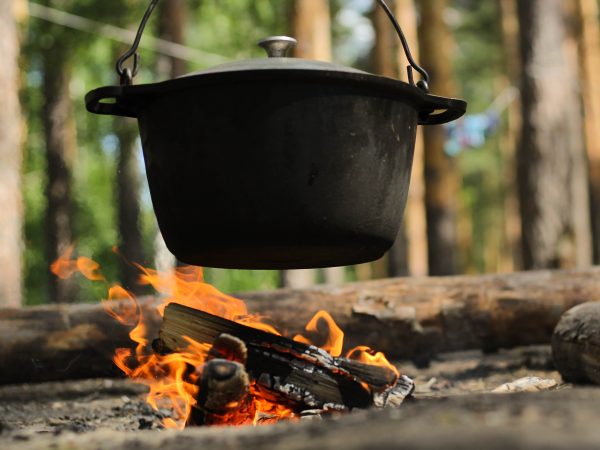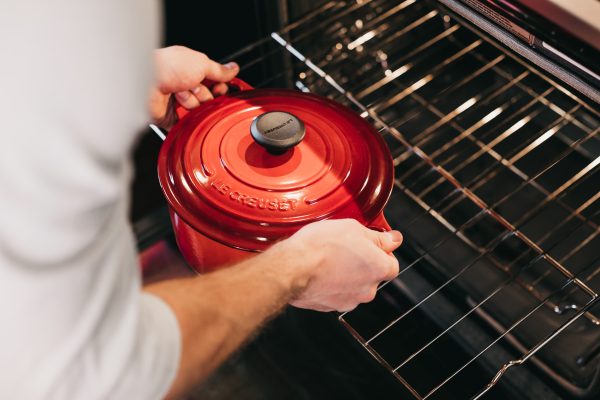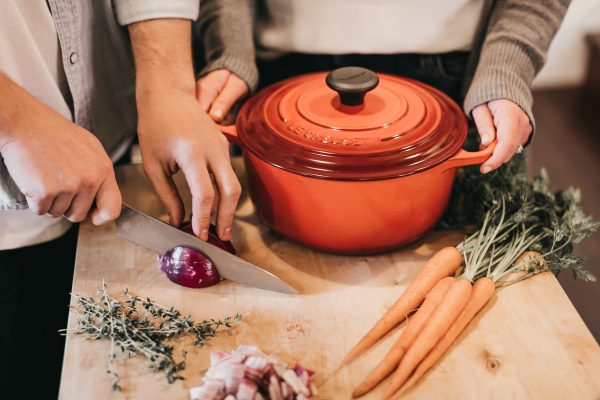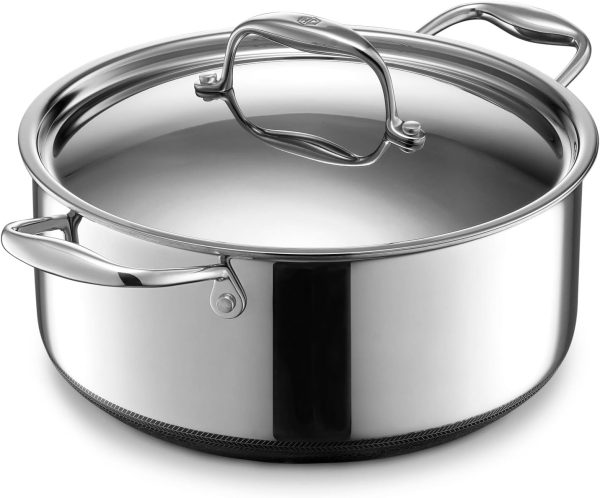Alright, foodie friends, let’s talk about a kitchen classic that’s making a comeback in a big way – the Dutch oven. These kitchen chameleons are stealing the spotlight in the cooking world, and we’re diving headfirst into their magic. Buckle up as we embark on this journey of Dutch oven discovery – it’s about to get saucy!
Dutch Ovens Unveiled – More Than Just a Pot.
Imagine a pot that’s more than just cookware – it’s a culinary superhero. It effortlessly switches from stovetop to oven, crafting dishes with the grace of an acrobat. The Dutch oven is the ultimate multitasker that has journeyed from campfires of old to become the MVP of modern kitchens. The Dutch oven’s secret weapon? Its ability to retain and distribute heat flawlessly, thanks to its robust materials. Crafted from substances that rival even the sturdiest rocks, Dutch ovens excel at absorbing and evenly spreading heat, ensuring each ingredient shines in a symphony of flavor. Whether you’re simmering a stew, braising a melt-in-your-mouth roast, or baking a bakery-worthy loaf, the Dutch oven stands ready.

Dutch Oven Material Showdown
Enter the Dutch oven duel! Starting with the bare cast-iron contenders – these are the traditionalists, masters of heat retention for slow-cooked perfection. But there’s a catch, and it’s all about commitment – they need extra care and seasoning to stay in tip-top shape.
Now, introducing the enameled cast-iron stars, often hailed as French ovens – the darlings of the modern kitchen scene. They blend the best of Dutch oven benefits with easier maintenance. Le Creuset’s luxurious creations might raise an eyebrow at the price tag, but the lifetime of loyal service justifies the splurge.
And here’s a wildcard – ceramic Dutch ovens. They’re the lightweight option that’s user-friendly, sparing your muscles. However, there’s a fragility factor – rapid temperature changes or accidental drops can lead to some unexpected cracks. But they make up for it with style points, bringing a touch of elegance to your cooking arena.

Size Matters, Right? Picking the Perfect Dutch Oven Size.
When choosing your Dutch oven wingman, consider your regular cooking crew. Are you a dinner-for-one aficionado, or do you tackle cooking like a team sport? Think about those times you love whipping up large batches of comforting soups or stews – perfect for future meals or freezing for busy days. The beauty is, most brands have you covered with a range of sizes, spanning from super small to, well, absolutely massive.
Take Le Creuset’s Round Dutch Oven, for example. It’s like the Goldilocks of kitchen gear, offering options for every appetite. Le Creuset’s smallest Dutch oven serves one or two people – ideal for those intimate dinners. But if you’re hosting a culinary extravaganza, the largest (a whopping 13 ¼ quarts) can satisfy more than nine hungry souls. Feeling caught in between? The 5 ½-quart size, dishing out five or six servings, sits comfortably in the middle – a true crowd-pleaser. So, before you dive into the Dutch oven world, size it up – after all, cooking up a storm is much more fun when you’ve got the perfect pot to match.
Lid Lingo – The Magic Behind Dutch Oven Lid Types
Let’s delve deeper into the world of Dutch oven lids – those unsung heroes that truly shape the culinary experience. Each lid type, be it flat, domed, or self-basting, has its unique set of pros and cons that contribute to the orchestration of flavors and textures.
Flat Lids
Flat lids provide an even surface, allowing you to stack other pots or pans on top, saving valuable stovetop real estate. They are also typically easier to clean due to their simple design. When it comes to baking bread or casseroles, the flat lid can double as a baking dish in the oven. The downside of flat lids is that they might not provide as tight of a seal as other lid types. This could result in some moisture loss during long cooking times, affecting the overall tenderness of your dishes. They also lack the self-basting effect that other lids can offer.
Domed Lids
The domed shape of these lids allows for better moisture retention. As steam rises and collects at the top, it drips back down onto the food, enhancing the self-basting effect. This is particularly beneficial for slow-cooked dishes that require consistent moisture throughout the cooking process. However, the curved design might limit your ability to stack other pots on top of the Dutch oven. Additionally, domed lids can be a bit trickier to clean due to their shape.
Self-Basting Lids
Self-basting lids have small spikes or nodules on the underside that capture and redistribute moisture as it condenses. This ensures a consistent and continuous basting process, leading to exceptionally tender and flavorful results. These lids are often more complex in design, which might make them slightly more challenging to clean. Their intricate structure can also make them prone to potential damage if not handled with care.
Ultimately, the choice of lid type depends on your cooking style and preferences. For dishes that benefit from consistent moisture circulation, like braises and stews, a domed or self-basting lid might be the way to go. If you value versatility and space-saving, a flat lid might be more practical. Whichever you choose, remember that the lid is a crucial player in the Dutch oven symphony, adding depth and richness to every culinary composition.

Love Your Dutch Oven – A Little TLC Goes a Long Way.
Remember, your Dutch oven isn’t just a kitchen tool – it’s a cooking confidante. Much like a treasured friend, it deserves a little extra attention to keep the bond strong and the culinary adventures flourishing. Taking care of your Dutch oven isn’t just maintenance; it’s an act of respect for the vessel that transforms your ingredients into mouthwatering masterpieces.
How to Care for Traditional Cast Iron Dutch Ovens
Just like seasoned friendships, your traditional cast iron Dutch oven thrives with a bit of regular seasoning. This process involves creating a non-stick surface that’s not only functional but also imparts a unique depth of flavor to your dishes. Begin by washing your Dutch oven with mild soap and warm water, gently scrubbing away any residue. Dry it thoroughly to prevent rust, and then apply a thin layer of cooking oil to all its surfaces, including the lid’s underside.
Now, here’s the secret: heat. Place your Dutch oven upside down in the oven at a low temperature, around 300°F (150°C), for about an hour. This process allows the oil to bond with the iron, creating that coveted non-stick finish. Remember, this isn’t just about preserving the pot’s functionality; it’s about infusing each dish with a touch of history and flavor.
How to Care for Enameled Cast Iron Dutch Ovens
Enameled Dutch ovens offer a sleek and modern approach to cooking, but they still appreciate some tender loving care. Gentle cleaning is the name of the game here. Avoid harsh scrubbers or abrasive cleaners that could damage the enamel surface. Opt for warm, soapy water and a soft sponge to clean off any residue after each use.
When it comes to cooking, moderate heat is your ally. While enameled surfaces are more resistant to staining and sticking, extreme temperature changes might cause the enamel to chip or crack. A gradual increase or decrease in heat is the best way to ensure your Dutch oven’s longevity.
Proper Storage
After each culinary escapade, give your Dutch oven a quick wash and dry to prevent any lingering moisture from causing rust. For traditional cast iron Dutch ovens, a light rub of cooking oil after washing can help maintain its seasoned surface. Store it in a cool, dry place with the lid slightly ajar to allow for proper air circulation. Enameled cast iron Dutch ovens can be stored without the need for additional seasoning; simply ensure they are clean and dry before tucking them away.
Game-Changer Alert – HexClad’s Fusion of Flair and Function.
But hold the spatula, folks – we’re not done yet! Introducing the HexClad 5 Quart Hybrid Nonstick Dutch Oven. Brace yourself for a kitchen revolution that’s equal parts innovation and functionality. This cookware marvel mixes top-notch stainless steel with a slick non-stick surface, all thanks to their signature hexagonal design. Tri-ply construction? Check. Heat distribution that’s off the charts? Double-check.
For the health-conscious foodie, the HexClad Dutch Oven is here to steal the show. It’s completely non-toxic and PFOA-free, using a blend of ceramic, diamond dust, and stainless steel. It’s like cooking with a sprinkle of culinary magic, all wrapped up in one pan. And talk about versatility – the HexClad Dutch Oven is a true showstopper. It plays nice with all cooktops – induction, gas, electric, and ceramic. And when your kitchen creativity takes a wild turn, this baby can handle oven temperatures up to a whopping 500 degrees Fahrenheit. Searing, roasting, or baking – it’s your culinary playground. The HexClad Hybrid Nonstick Dutch Oven laughs in the face of metal utensils, avoiding scratches like a pro. And guess what? While it’s dishwasher-friendly (because who wants to scrub?), giving it a little hand-washing love is the secret sauce to keeping it shiny and spotless. We think that HexClad’s Hybrid Nonstick Dutch Oven is the full package – roomy enough to satisfy your cooking dreams and packed with HexClad’s signature innovation and quality.
Dutch Ovens Decoded
As our journey through the captivating world of Dutch ovens comes to a close, remember that these cookware companions are more than just tools – they’re vessels of tradition and innovation. Whether you’re simmering stews, baking bread, or roasting to perfection, your Dutch oven is a partner in your culinary story. So, let the sizzle, aroma, and anticipation fill your kitchen, creating memories that linger through every delightful bite. As you embrace the art of Dutch oven cooking, may your creations be as vibrant and flavorful as the journey itself.
